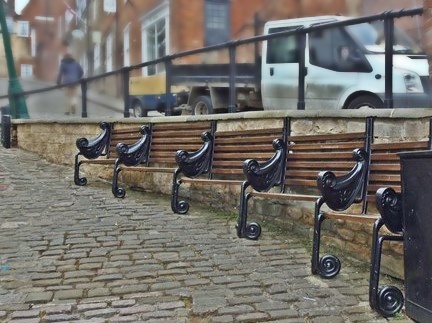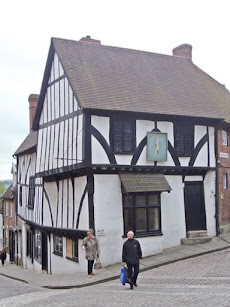William Dyke was the licensee of the George and Fox in Penkridge in Staffordshire 1869 to 1880, he then became a beerseller, his assets were liquidated in December 1881. By 1891 he was living in Orchard Street, Lincoln and employed a corn merchants labourer, probably for Henry Elsey who was a lodger in his home.
William and his wife had two of their children living with them in 1891. Their oldest child, Albert George Dyke, worked as a confectioner.
Albert was a successful racing cyclist, gaining many cups, statuettes, vases, shields during his racing career. He began racing in 1880 when he lived in Staffordshire. Albert was asked by a Lincolnshire Echo reporter why he was not racing under his own name, his response "... when I started racing I raced under my own name I was then 16 and was apprenticed at Wolverhampton. In 1881, I had a bad smash, and my employer then said he would not allow me to race, but I thought I could do something, so I decided I would try. I wrote to the NCU* and the AAA*, stating my case, and asking that I be allowed to ride in a family name R M Wright. I was granted permission, but with the condition that I never ride in any other name so long as I live." He rode under his brother in laws name, Ralph Montague Wright.
Albert started his business by selling Sunbeam bicycles from his home in Orchard Street in 1892
He married local woman Rose Emma Horner in 1894. Between 1895 and 1902 they had 3 children, the last was Ralph Montague (R M) Wright Dyke, named obviously with intention of taking over the business later, sadly Ralph died in 1903.
Wrights launched the "Stonebow Autocar" made by Payne and Bates of Coventry in 1900. R M Wright & Co were the first motor dealers in Lincoln
Wrights also sold a range of Stonebow Cycles.In the 1901 Census Albert and Rose were living at 88 Bailgate, Lincoln,his occupation was shown as ”Cycle & Motor Manufacturers Agent”. By 1911 they were living close to the business at 12 Newland .
He was a keen motorist involved with motoring clubs in Lincoln and Nottingham, this led to the early success of his business; he entered competitions in the name of R M Wright to give publicity to his business. To prove the reliability of the Humber car he organised a 5,000 mile trial. He also took part in other trials.
Albert was what we would today call a "boy racer", convicted many time of riding a bicycle (even in a race) or driving a car "furiously" and driving at excess speed, ranging from 7 to 27 mph.
Their showroom on Newland featured a vehicle lift so that cars could be raised to the first floor showroom. This showroom would accommodate over 30 cars.
Incorporated as R M Wright & Co Ltd before 1919.
R M Wright became Austin distributors in 1922
Albert’s wife died in Lincoln in1927.
The company was taken over in 1927 and became R M Wright (1927) Ltd., the directors were Frederick Arthur Cox, Margaret A Cox and John Charles Ivens; F A Cox was managing director of the company. Frederick Cox died in November 1938, he had been ill for over 5 years. John Ivens became managing director. 1953 entry from www.gracesguide.co.uk R. M. Wright & Co. (1927) Ltd. Car and Light Commercial Vehicle Stockists. Newland, Lincoln. Telephone: 397. Directors: J. C. Ivens (Managing). M. A. Cox. F. R. Cox. Peter J. C. Ivens (Sales Manager). Managers: S. Pinder (Service—Repairs). F. H. Kirby (Spares).
Albert Dyke died in Oswestry in 1940
R M Wright (1986) Ltd was acquired by the Lincolnshire Co-operative Society Limited in1986
Wrights remained as distributors for Austin motor vehicles, continuing through British Motor Corporation, the nationalised British Leyland Motor Holdings, British Leyland and the Rover Group. Unfortunately, financial health of the company was closely linked to that of its supplier. It was obvious to the owners of the company that the Rover Group was in trouble so it was decided that R M Wright, after nearly 100 years of trading, would be wound up and the Lincoln premises on Outer Circle Road would be re-branded as Holland Bros and the more appealing Jaguar products would be retailed.
In early 2012 Lincolnshire Co-operative Ltd sold Holland Bros to the Marshall Motor Group.
*National Cyclists Union
*Amateur Athletics Association








































